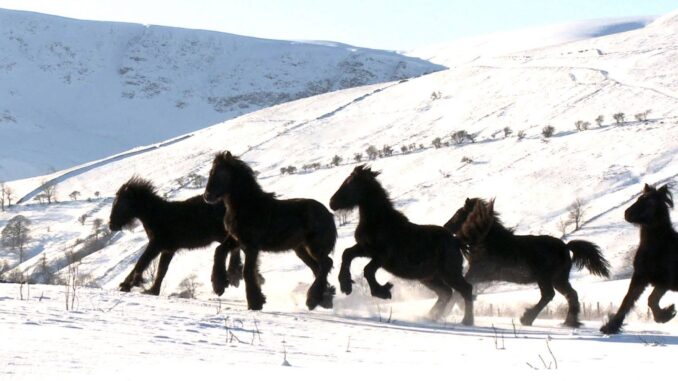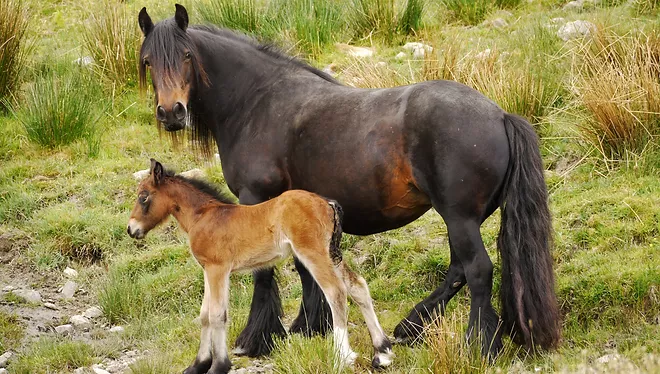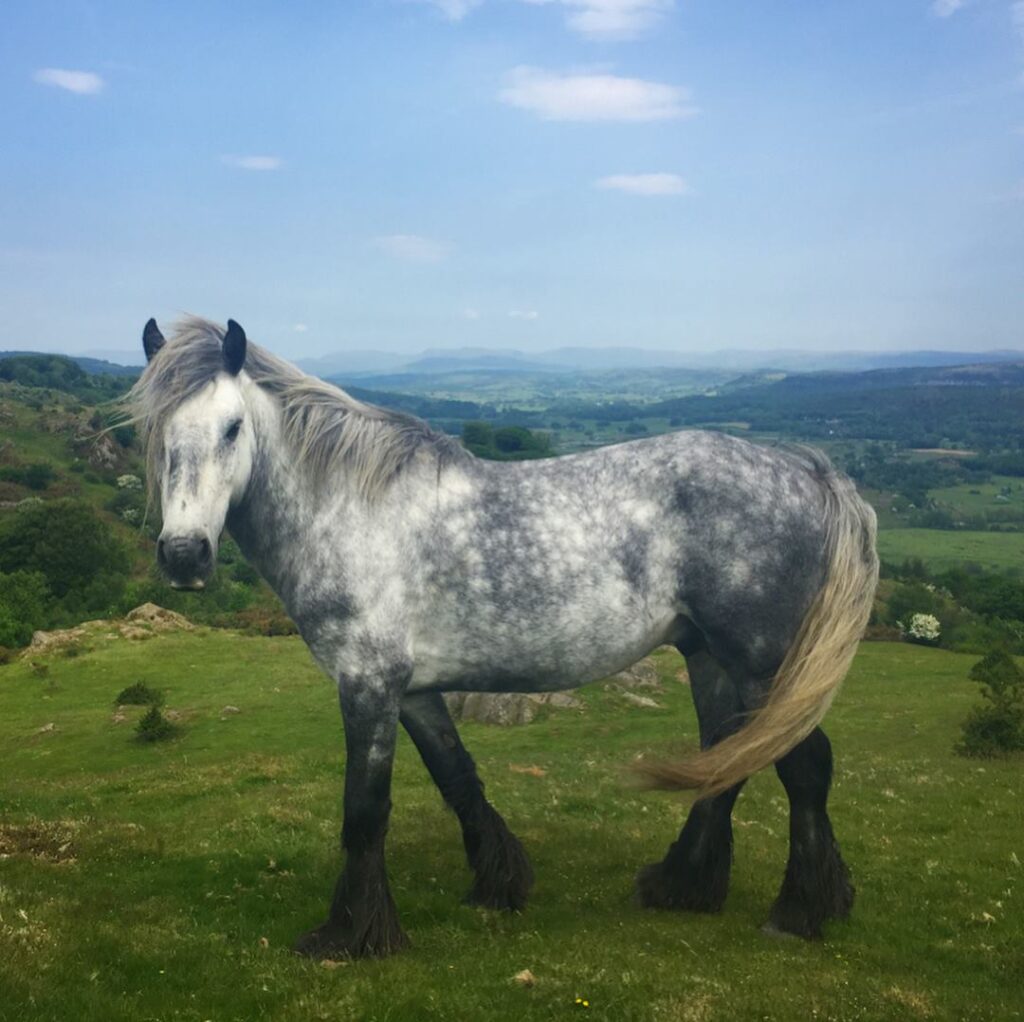
The Fell Pony is a special case.
Bio-Diversity Net Gain is a concept which is now at the centre of British government policy towards nature recovery, particularly in agriculture. The Environment Act 2021 made it a statutory requirement that any development must leave the natural environment in a measurably better state than previously. There are two main mechanisms for delivering the policy – the Planning Control system and the agricultural subsidy system. Bio-Diversity Net gain will replace state subsidy for food production with state subsidy for nature conservation. The process is already underway, and the Fell pony might be an early casualty.
Fell Ponies are an iconic Cumbrian rare breed. They are one of a small handful of species which are uniquely characteristic of the Lake District World Heritage Site, which makes clear and specific references to the importance of its unique Cultural Landscape, and which includes its native species. The Fell pony is no less characteristic of the unique identity of the Lake District than the Herdwick sheep, the Golden Eagle, and the Arctic Char, and significantly more representative of that unique identity than the red squirrels, otters, kites, ospreys, and deer, all of which are commonly used to illustrate characteristic Lake District wildlife. Despite this iconic status, the profile of the native Fell pony in the popular imagination, and in representations of the Lake District landscape and culture, and in the policies of conservation organisations, appears to be unjustifiably significantly lower than all the species mentioned.
This relatively low profile has not had serious consequences for the Fell pony breed until the last few years, when the very existence of the free-running herds on the high fells has been brought into question by Agri-environment schemes which seek to reduce the intensity of livestock grazing as part of a move towards nature recovery and ‘rewilding’ , recently re-christened ‘bio-diversity net gain. In some locations, these herds are now seen as a threat to their own habitat, because their existence is not compatible with the progressive ideals of a more natural environment. This is a curious development, because the Fell ponies were living semi-wild on the fells for hundreds of years before conservation science decided that they were out of place. The Fell pony has helped to create the unique habitat and unique culture which has been deemed worthy of World Heritage Site status, and they deserve special recognition and special treatment, rather than exclusion and persecution.

There are several reasons for this strange reversal. The number of Fell ponies running free on the fell is small compared to Herdwick sheep, – so small that the ponies are classed as ‘Vulnerable’ by the Rare Breeds Survival Trust, and so they are less visible to tourists, and they have not been promoted by Lake District marketeers, as have the Herdwicks, the red squirrels, and the ospreys. The upland herds of Cumbrian Fell ponies are among the wildest of the native equines, and the free running herds are only semi-domesticated. They mostly have rights to graze common land, where they are closer to nature and different in kind from any farm livestock reared as a source of food. Because the British do not, in general, eat horsemeat, the perceived commercial value of the Fell ponies is low compared to sheep and deer, and they are seen as part of the ‘leisure’ economy, and not as agricultural. While compensation is paid under Agri-environment schemes to sheep graziers, and a deer-stalking or grouse-shooting enterprise might yield significant profits, the Fell ponies and their breeders are few in number and they do not attract the same level of support as meat producers. Schemes to reduce grazing intensity on the high fells cannot in any case compensate for the loss of genetic diversity and loss of the characteristic breed type which will follow the eradication of the un-domesticated herds.

As more ponies are kept in lowland conditions away from their natural habitat, and living in stables and fed with concentrates on grassy fields, so the number of fell-running herds dwindles, and the special qualities needed for living on the fell are giving way to show-ring characteristics. The special characteristics of the hill bred herds can be summarized as follows:
- The biggest, finest, and best-behaved Fell ponies which win the prizes at shows and gymkhana are not necessarily, and in fact not usually, the best breeding stock or the best mothers.
- The high fells are the ponies’ natural habitat. The rough grazing, the rugged landscape, the severe micro-climate, the diversity of plants in the upland environment, the experience and judgement of the breeders and the selective grazing patterns learned from their mothers have all shaped the evolution of the breed and the environment.
- The wildest and scraggiest looking ponies on the fell are frequently the hardiest, the most fertile and the most successful at rearing good strong foals in their natural environment. These ponies have usually never been handled, and many have never had a halter on them, so most people would not want to own them, either for their looks or for their temperament or ease of handling, and yet year after year they provide the foundation stock for the good looking, well-behaved, quite tempered and prize winning ponies which are sold off the fells and go all over the country.
- A hill-bred pony is small in size and has a particular shape, with deep chest, large gut, great stamina, and exceptional hardiness. They thrive on rough grazing, with good hard feet, sure-footedness among the rocks and bogs, with a low-set tail, long body hair, mane, and tail.
- They have exceptionally good balance and a smooth leg action which makes them pick up their feet. It is not for nothing that the Fell pony is among the very best driving ponies, favoured for speed, temperament and agility by HRH Prince Philip and many others.

Exmoor and Eriskay ponies are now imported into the Lake District for the purposes of controlled conservation grazing on sensitive sites, while at the same time the native semi-domesticated herds which graze all year round are being squeezed out. In order to achieve precise targets for the optimum height of different species of vegetation, the heavily-subsidized conservation grazers can be micro-managed, by turning them on and taking them off the high fells and commons exactly to order, and then taking them back to their home fields. The semi-domesticated Fell pony herds have been grazing the fells all year round since time immemorial, and most hill breeders are not tempted to remove their herds in return for subsidy, no matter how generous, but if they do not remove them voluntarily, they are being forced. The herds of Fell ponies grazing the common are now seen as part of the problem, whereas in reality they are an integral part of the ecosystem which have made the landscape what it is.
To summarize: The worth of the upland herds of Fell ponies has been consistently overlooked and undervalued, to the detriment of the special characteristics of the breed and the erasure of a unique Lake District culture. These herds make a vital contribution as the foundation stock for an iconic breed, and they have helped to shape the upland environment to make it worthy of World Heritage Site status. It would be a tragic failure if policies intended to protect our natural heritage have the effect of diminishing it.
Bill Lloyd, 27 January 2021,
with thanks to Libby Robinson, Fell Pony Heritage Trust
Chair, Fell Pony Breeders Association 2018-2021


